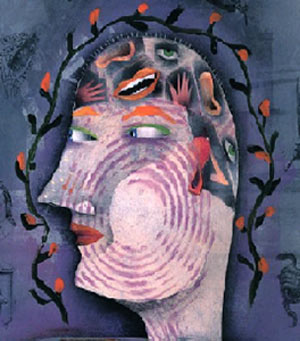- SELF STUDY MODULES
- 1. Intro to TBI
- 2. Communication
- 3. Skills for independence
- 4. Cognitive changes
- 5. Behaviour changes
- 6. Sexuality
- 7. Case management (BIR)
- 8. No longer available
- 9. Mobility & motor control
- 10. Mental health & TBI:
an introduction - 11. Mental health problems
and TBI: diagnosis
& management - 12. Working with Families
after Traumatic Injury:
An Introduction - 13. Goal setting
- 11.0 Aims
- 11.0A Take the PRE-Test
- 11.1 Mental health & mental illness & TBI
- 11.2 Factors affecting the risk of psychiatric illness after a TBI
- 11.3 The brain and psychiatric illness
- 11.4 Severity of a TBI
- 11.5 Types of mental health problems after a TBI
- a) Mood disorders
- b) Psychotic disorders
- c) Anxiety
- d) Personality
- 11.6 Sam : case study
- 11.7 Diagnostic challenges:
- a) Person with TBI
- b) Inherent in the disease
- c) Social environment
- d) Psychiatry and services
- 11.8 Management challenges
- a) Person with TBI
- b) Medical services
- c) Family
- d) Rehabilitation team
- 11.9 Take home messages
- 11.10 Resources
- 11.11 Take the POST-test
11.5b Psychosis
i) Psychoses
Psychosis is a disturbance of reality testing
Psychosis is, in its broadest definition, a disturbance of reality testing.
The person's perception of what is happening in the real world is altered by the illness. There is no comparison with what is occurring in the real world.
Psychosis can be characterised by the experience of:
- delusions
- hallucinations
- thought disorder.

ii) Delusions
Delusions are false fixed ideas that a person holds and these ideas are contrary to their cultural, social or religious beliefs.
The person maintains the idea despite being given evidence to the contrary.
The delusional idea must cause the person to change in terms of their emotions, their behaviour or their feeling state and thought processes. They have to act on the idea.
If the person has an abnormal idea that is not consistent with their reality but it does not cause a change in behaviour or emotional experience we call that an overvalued idea. Overvalued ideas are also found in psychotic states.
Distinguishing a delusion from a confabulated memory can be difficult. In confabulation the ideas often change according to the external stimulus (environment). Delusions are typically fixed and consistent.
iii) Hallucinations
Hallucinations are the experience of perceptional phenomena in external reality where there is no stimulus in the external reality.
For example, the person will hear the sounds or voices talking to them but there is no sound in the external reality.
Hallucinations can also take the form of visual, tactile and olfactory experiences. People can have the experience of smelling things that do not actually occur.
In the past it was thought that the auditory hallucinations were found only in the schizophrenias or functional psychiatric illnesses and that the hallucinations such as visual hallucinations or sensory somatic hallucinations were more commonly found in organic states. Research in traumatic brain injury populations found auditory hallucinations were very common.
iv) Thought disorder
Thought disorder is when a person's ability to construct their ideas and express those ideas is disturbed.
For example they will have problems with regard to their grammatical construction of sentences, they exhibit clang associations where each sentence ends with the same word and has a very rhythmic quality.
Thought disorder can be difficult to diagnose in people who also have a brain injury or any other damage to the central nervous system because the central nervous system is very important for the control and production of language.
People can have a stroke or traumatic brain injury in the areas of the brain that control language and they will have a problem with production of language. This is not thought disorder, this is dysphasia. The differentiation between the two can be difficult to discern.
v) Questions
Answer these questions:
Is a person delusional who has an abnormal idea not consistent with their reality where the idea does not cause a change in behaviour or emotional experience?
Is it easy to differentiate between thought disorder and dysphasia (a brain injury in the area of the brain controlling language)?
References:
1. Psychotic disorder due to traumatic brain injury: DE Fujii, NP Armstrong and I Ahmed. Chapter 13, in The Sectrum of Psychotic Disorder; Neurobiology, Etiology and Pathogenesis. Ed D Fujii, I Ahmed. Cambridge Press, United Kingdom. 2007.
2. Schizophrenia-like psychosis and traumatic brain injury. PS Sachdev. Chapter 13 in Secondary Schizophrenia. Cambridge Press. New York 2010.
3. Psychotic Disorder: A Wakin, D Malaspina, M Perrin, TW McCallister, C Corcoran. Chapter 11 : in Textbook of Traumatic Brain Injury. Ed. JM Silver, TW McCallister, SC Yudofsky. American Psychiatric Publishing. Washington 2011.
